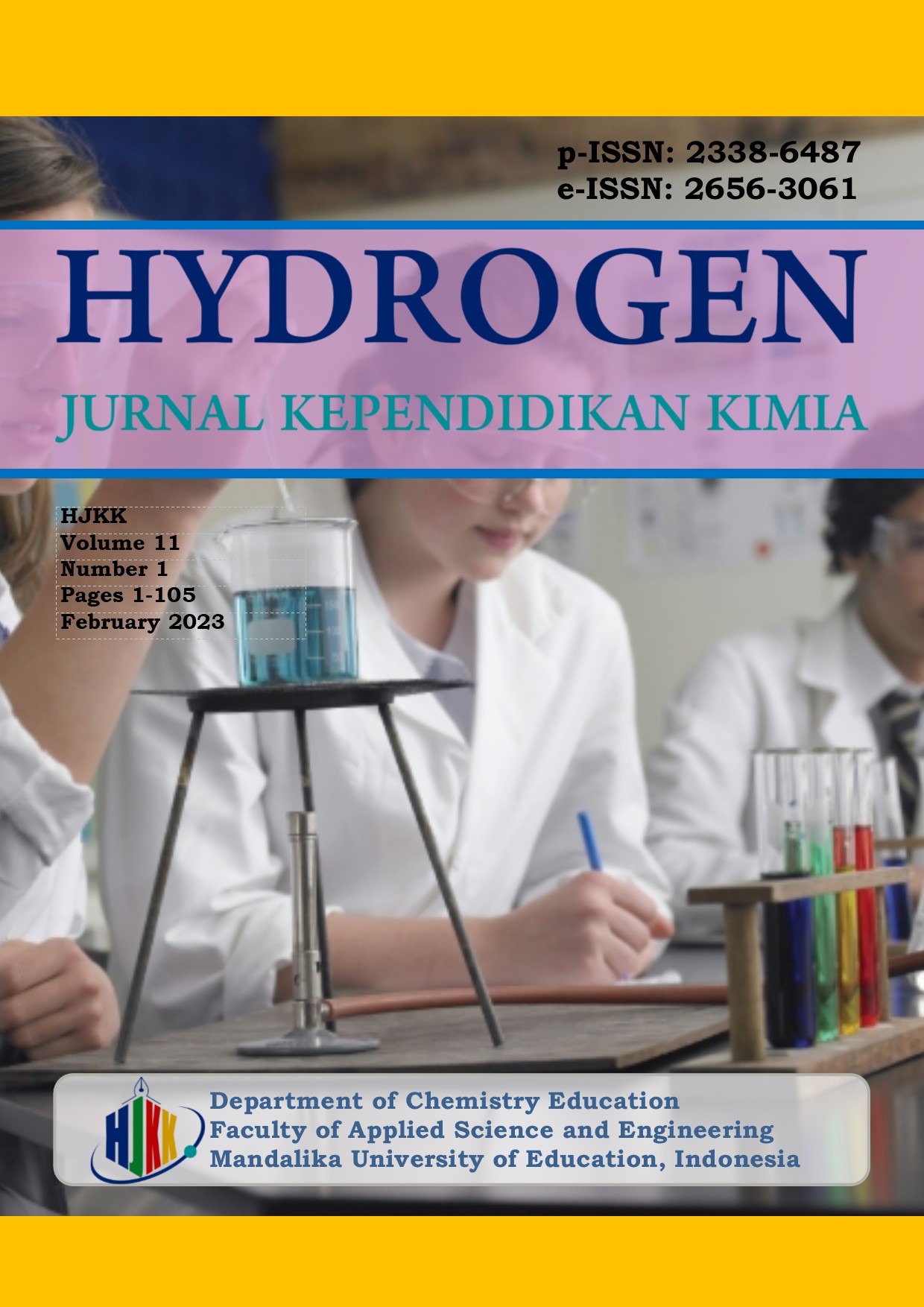Enhancing Science Literacy through Development of Acid-Base E-module using Book Creator
DOI:
https://doi.org/10.33394/hjkk.v11i1.5874Keywords:
e-module, scientific literacy, book creator, acid-baseAbstract
The aim of this study was to produce a science literacy-based e-module prototype using a book creator focused on acid-base material and to investigate user responses to the product. The Plomp model was utilized for the design of the research. The e-module was validated by two material experts and one media expert. The trial of user responses was conducted on teachers and students. The results showed that the e-module met the criteria for validity with a high average score of 97.14% for material substance and 97.27% for learning design. The media aspect received an average score of 96% for visual communication and 98.33% for software utilization. The responses of both teachers and students were positive, with average scores of 93.70% and 86.07%, respectively.
References
Abdullah, Herawati, dan Tarkono. 2013. Pengembangan Bahan Ajar Modul Interaktif Konsep Dasar Kerja Motor 4 Langkah Kelas X di MAN 2 Tanjung Karang. Jurnal Teknologi Informasi Komunikasi Pendidikan. 1 (1)
Ardian Asyhari dan Helda Silvia. 2016. Pengembangan Media Pembelajaran Berupa Buletin dalam Bentuk Buku Saku Untuk Pembelajaran IPA Terpadu. Jurnal Ilmiah Pendidikan Fisika Albiruni. 5 (1)
Badaruddin. 2020. Belajar Asyik Aksara Jawa dengan Book Creator. https://radarsemarang.jawapos.com/rubrik/untukmuguruku/2020/11/19/belajarasyik- aksara-jawa-dengan-book-creator/. Di akses pada 29 September 2022)
Eko Putro Widoyoko. 2012. Teknik Penyusunan Instrumen Penelitian. Yogyakarta. Pustaka Pelajar
Hayat, B. dan S. Yusuf. 2010. Mutu Pendidikan. Jakarta. Bumi Aksara
Kimianti, F., Suryati., & Dewi, C.A. (2016). Pengembangan modul learning cycle 5E berorientasi green chemistry pada materi sistem koloid untuk peningkatkan literasi sains siswa. Hydrogen: Jurnal Kependidikan Kimia, 4(2): 70-79.
MilenkovicÌ, D. D., Segedinac, M. D., & Hrin, T. N. (2014). Increasing high school students’ chemistry performance and reducing cognitive load through an instructional strategy based on the interaction of multiple levels of knowledge representation. Journal of Chemical Education, 91(9), 1409-1416.
Novia Fitri Jayanti. 2020. Desain dan Uji Coba E-Modul Android Berbasis Literasi Sains Terintegrasi Nilai Islam pada Materi Laju Reaksi. Skripsi. Universitas Islam Negeri Sultan Syarif Kasim Riau
Riduwan. 2011. Belajar Mudah Penelitian dan Pengembangan. Bandung. Alfabeta Sugiyono. 2019. Metode Penelitian Pendidikan Pendidikan Pendekatan Kuantitatif,
Kualitatif, dan R&D. Bandung. Alfabeta
Syamsurizal, Haryanto, dan Novi Chairani. 2015. Pengembangan E-Modul Berbasis Keterampilan Proses Sains Pada Materi Kesetimbangan Kimia Untuk Tingkat SMA. Prosiding SEMIRATA Bidang MIPA BKS-PTN Barat. Universitas Tanjungpura. Pontianak
Wahyudi Setiawan, Fitriah M Suud, A.S Rahmatullah. 2018. Pendidikan Kebahagiaan Dalam Revolusi Industri 4.0. Jurnal Studi Kependidikan dan Keislaman. 5 (1): 101
Widarti, H.R. (2020). Multiple representations in chemistry learning: A study on teacher’s literacy. AIP Conference Proceedings 2330, 020042 (2021); https://doi.org/10.1063/5.0043360
Yuliati, Y. (2017). Literasi sains dalam pembelajaran IPA. Jurnal Cakrawala Pendas, 3(2). doi:http://dx.doi.org/10.31949/jcp.v3i2.592
Downloads
Published
How to Cite
Issue
Section
Citation Check
License
License and Publishing Agreement
In submitting the manuscript to the journal, the authors certify that:
- They are authorized by their co-authors to enter into these arrangements.
- The work described has not been formally published before, except in the form of an abstract or as part of a published lecture, review, thesis, or overlay journal.
- That it is not under consideration for publication elsewhere,
- That its publication has been approved by all the author(s) and by the responsible authorities – tacitly or explicitly – of the institutes where the work has been carried out.
- They secure the right to reproduce any material that has already been published or copyrighted elsewhere.
- They agree to the following license and publishing agreement.
Copyright
Authors who publish with Hydrogen: Jurnal Kependidikan Kimia agree to the following terms:
- Authors retain copyright and grant the journal right of first publication with the work simultaneously licensed under a Creative Commons Attribution License (CC BY-SA 4.0) that allows others to share the work with an acknowledgment of the work's authorship and initial publication in this journal.Â
- Authors are able to enter into separate, additional contractual arrangements for the non-exclusive distribution of the journal's published version of the work (e.g., post it to an institutional repository or publish it in a book), with an acknowledgment of its initial publication in this journal.
- Authors are permitted and encouraged to post their work online (e.g., in institutional repositories or on their website) prior to and during the submission process, as it can lead to productive exchanges, as well as earlier and greater citation of published work.
Licensing for Data Publication
Hydrogen: Jurnal Kependidikan Kimia uses a variety of waivers and licenses, that are specifically designed for and appropriate for the treatment of data: Open Data Commons Attribution License, http://www.opendatacommons.org/licenses/by/1.0/ (default) Other data publishing licenses may be allowed as exceptions (subject to approval by the editor on a case-by-case basis) and should be justified with a written statement from the author, which will be published with the article.







